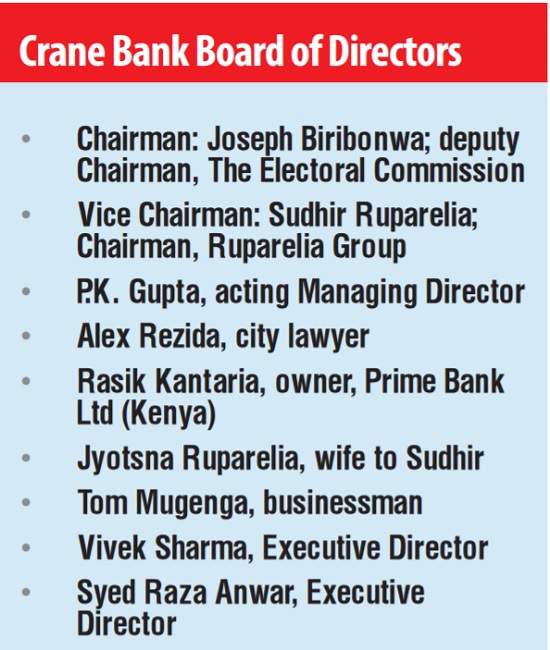KPMG’s report
They already knew that in 2015, the three D-SIBs accounted for about 36% of total banking sector assets. Danger signs started emerging when a decline in asset quality was reported among D-SIBS with NPL ratio rising from 3.5% in December 2014 to 7.6% in December 2015, according to the 2015 Financial Institutions Supervision Report. The decline in quality among DSIBs was mainly attributed to Crane Bank, which reportedly had “a significant exposure to one borrower.”
KPMG, an international audit firm, has over the years been Crane Bank’s external auditors. Their most recent audit report – which the auditors gave a ‘qualified opinion’ – showed that the bank had paid up capital amounting to Shs 260 billion – way above BoU’s statutory requirement of Shs 25 billion. In his takeover statement of Crane Bank, BoU Governor Mutebile said their decision followed a determination by BoU that the bank was “a significantly under-capitalised institution” and “posed a systemic risk to the stability of the financial system” and that the continuation of its activities in its current form was detrimental to the interests of its depositors. Some analysts wonder whether Mutebile got to know about this situation in October. Consequently, BoU is now being forced to respond to what it describes as “false and malicious rumours” regarding the stability of the financial sector as a whole. This is a major reversal as over the years, BoU, as the regulator, has won plaudits for creating order in the financial sector through sound monetary policy management.

A source familiar with the country’s banking industry told The Independent that out of the Shs 700bn worth of NPLs in the banking industry, Crane Bank contributed 20% of all the bad loans.
To make matters even worse, the money was lent to a few big clients to the tune of between Shs 40 billion – Shs 50 billion. This was risky according to the source, as it implied that in case anything happens in the economy, as has been the case recently, you are hit hard. Most banks find it safer to spread the risk to into many smaller loans to many smaller clients.
Stanbic Bank CEO Patrick Mweheire suggested that BoU has more work to do as seven other commercial banks are still loss-making as cost to income ratio (CTI) is still very high, with 16 out of the 25 banks having their CTI above 70%. This implies that the majority of commercial banks are incurring high expenditure to make minimum income.
Salima Nakiboneka, a financial analyst with Crested Capital, and Stephen Kaboyo, the managing partner at Alfa Capital, a financial advisory firm, also appear to give the same prognosis. Nakiboneka says the banking industry has been relatively sluggish over the past few months characterised by low private sector credit, and commercial banks are making most of their profits from non-lending activities.
Kaboyo adds that given that commercial banks play a growth-enhancing role for the economy by providing credit, the failure of Crane Bank could have adverse effects on economic activities especially among smaller businesses. “In my opinion, the market segment of downtown traders will bear the brunt of the pain from the Crane Bank situation,” he says. “There will be down-time for those [businesses] that the bank has been supporting, including job losses.”
Indeed, going forward, the fall of Crane Bank presents serious challenges. Because of its size, no bank can come forth to acquire its assets and liabilities. Private equity firms could be given an opportunity to purchase. However, given the nature of PE, they will come in and utilize the cheap deposit base as a pool of liquidity and capital for higher returns and ignore the traditional lending to small companies. “In my view with the fall of Crane Bank, the gap dividing Kampala Road and downtown is likely to grow wider with respect to banking services,” Kaboyo said.
Economist Fred Muhumuza of Makerere University School of Economics and Business Sciences Management suggested that many could have seen Crane Bank’s predicament coming. He noted that there are reports that the owners used the money to acquire real estate assets and then never brought actual money back to the bank. He reasoned that the health of a bank can be lost in a very short time depending on how fast the NPLs increase. “If any big loan fails or depositors loose trust and go away, the bank just becomes sick. The bank’s health got bad so quickly from 2014,” he said. This was about the time that A.R Kalan, the bank’s long-serving MD, vanished mysteriously. Gupta, his replacement, has been working in acting capacity for two years.
Muhumuza thus cites the corporate governance challenges that Crane Bank has been facing, including having Sudhir, as the main shareholder, and vice chairman. “He has been too close to the day-to-day operations and thus having too much influence on the management,” he said. Other analysts say Crane Bank’s board, chaired by Elector Commission Vice Chairman Joseph Biribonwa was “very weak and fragile in comparison to those of its Tier 1 peers.
According to the Financial Institutions Act 2004, BoU can take over management of any bank when they see a systemic risk that would endanger the interests of depositors. It is expected that in the next few months, the statutory manager, Edward Katimbo Mugwanya, will attempt to recover all the outstanding loans as per their contracts and will work with BoU to ensure that Crane Bank’s bank’s previous liquidity and management challenges don’t spill over to the larger economy.
Should the manager realize that the financial institution won’t comply with standards within six months after being placed under statutory management or fails to get a buyer, the Central Bank could close it and put it under receivership.
****
editor@independent.co.ug
 The Independent Uganda: You get the Truth we Pay the Price
The Independent Uganda: You get the Truth we Pay the Price




It`s a pity. failure like this is ususallly never down to only 1 reason, but to a number of reasons that present themselves in quick succession. It was a beacon to indigenous banking.
This is sad but we believe God for much better in the banking sector and an elevation in our economy.